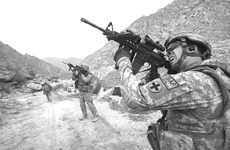
(AP) – The White House said President Barack Obama could use an unusual evening war council session Monday to lock in his long-awaited decision on whether to commit tens of thousands of new U.S. forces to the stalemated war in Afghanistan.
Military officials and others said they expect Obama to settle on a middle-ground option that would deploy an eventual 32,000 to 35,000 U.S. forces to the 8-year-old conflict.
That rough figure has stood as the most likely option since before Obama’s last large war council meeting earlier this month, when he tasked military planners with rearranging the timing and makeup of some of the deployments.
The president has said with increasing frequency in recent days that a big piece of the rethinking of options that he ordered had to do with building an exit strategy into the announcement – in other words, revising the options presented to him to clarify when U.S. troops would turn over responsibility to the Afghan government and under what conditions.
The presidential spokesman said it was possible Obama could lock in a decision at Monday’s meeting or that it could come “over the course of the next several days.” In either case, it will not be announced this week, he said.
The force infusion expected by the military would represent most but not all the troops requested by Obama’s war commander, for a retailored war plan that blends elements of Gen. Stanley McChrystal’s counterterror strategy with tactics more closely associated with the CIA’s unacknowledged war to hunt down terrorists across the border in Pakistan.
McChrystal presented options ranging from about 10,000 to about 80,000 forces, and told Obama he preferred an addition of about 40,000 atop the record 68,000 in the country now, officials have said.
Obama has already ordered a significant expansion of 21,000 troops since taking office. The war has worsened on his watch, and public support has dropped as U.S. combat deaths have climbed.
The additional troops would be concentrated in the south and east of Afghanistan, the areas where the U.S. already has most of its forces, military officials said. The new troops that already went this year were directed to help relieve Marines stretched to the limit by far-flung postings in Helmand province and that would continue, while the U.S. effort would expand somewhat in Kandahar.
The increase would include at least three Army brigades and a single, larger Marine Corps contingent, officials said.
All officials spoke on condition of anonymity because the decision is not final.
U.S. war planners would be forgoing the option of increasing U.S. fighting power in the north, a once-quiet quadrant where insurgents have grown in strength and number in the past year. But McChrystal’s recommendation never called for a quick infusion there.
As originally envisioned by McChrystal, the additional U.S. troops would begin flowing in late January or after, on a deployment calendar that would be slower and more complex than that used to build up the Iraq “surge” in 2007. McChrystal’s schedule for full deployment has it taking nearly two years, military officials said.
The relatively slow rollout is largely driven by logistics. But it also could give the White House some leverage over Afghan President Hamid Karzai. U.S. officials note that where and how fast troops are deployed are a means to encourage fresh and more serious efforts at cooperation and clean government in Afghanistan.
The White House is aiming for an announcement by Obama by the middle of next week, after Congress returns from its Thanksgiving break.